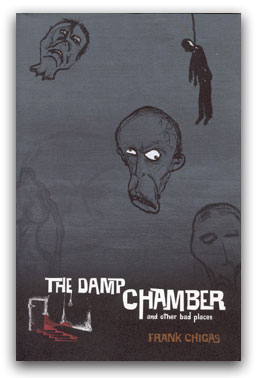
The Damp Chamber
and Other Bad Places
Frank Chigas
Review by Alyce Wilson
Like H.P. Lovecraft before him, Frank Chigas, author of The Damp Chamber, a collection of short stories, creates his own supernatural mythos, populated by denizens of the other world, determined to cross into this one.
In stories that vary in time and place, he tells tales that frequently involve the threat of creatures crossing from one world into another.
Sometimes science is involved, in stories like "In the Shadow Room" or "Yet Another God." Sometimes, it's because of somebody's foolish greed or pride, as in "The Copper Bell" and "The Fourth Column." And sometimes it's simply the result of somebody trespassing into the world of the damned, such as " The House of August" and "She Is a Picture in Black."
The creatures in these stories share similarities. They often have elongated limbs and are pale, a little like cave creatures who have not been exposed to the light. And often, though they resemble humans, there is something essential missing, such as a face.
While some of these stories have happier resolutions, the happiest result is simply escaping from these horrors, sometimes barely.
And so the overall effect of the book is a feeling of dread, a fear of the unknown. And that, of course, is the essential quality of a scary story. That's why an Alfred Hitchcock movie may be scarier than a modern slasher flick.
The fear of the unknown is one of the greatest motivations in this life, what makes us stick with the known rather than venture out to the unknown possibilities.
Regardless of the setting, each of the protagonists is sort of every man (and each of them is, actually, a man, not a woman amongst them), who finds out about some strange goings-on. Usually, he is the one left to tell the tale afterwards. Although on some occasions, the tale is continued through journal entries.
He frequently uses the motif of written journals. It helps him to tell a story of people no longer around to tell them themselves, and to give history on how they started out on their doomed paths.
These stories, taken together, do what Lovecraft did, creating a dark mythos of creatures found under rocks or in dark corners, coming through from the netherworld. Frequently, the creatures then alter the people they encounter, whether turning them into a featureless being such as themselves, contorting their limbs or otherwise distorting them.
I'm sure an English grad student would gladly pen a paper about the use of the "other" in Chigas' work and how it might point to human fears of those who are different from us, and the danger of communicating with the "other," in case you should be changed yourself.
So these are psychological tales, where fear comes from, not knowing
who the antagonists are, along with the realization that they have the
ability to forever alter those they encounter. These psychological tales
hearken back to the classic horror authors such as Lovecraft and Poe,
and his adept storytelling and refreshing style make for an engaging read.
Although probably not a book to read right before bedtime.
Medusa Press, 2004; ISBN 0-9725324-0-4